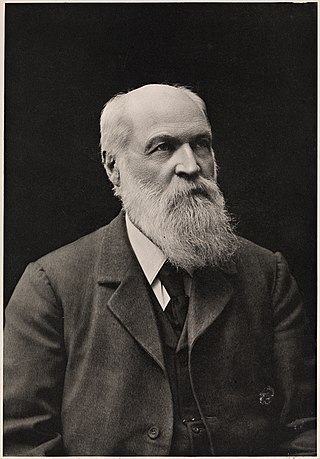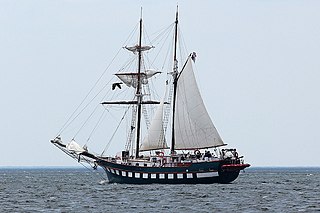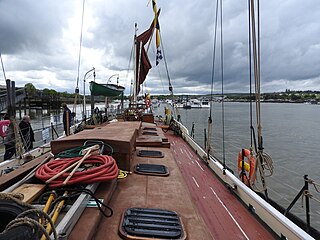
A brigantine is a two-masted sailing vessel with a fully square-rigged foremast and at least two sails on the main mast: a square topsail and a gaff sail mainsail. The main mast is the second and taller of the two masts.

A brig is a type of sailing vessel defined by its rig: two masts which are both square-rigged. Brigs originated in the second half of the 18th century and were a common type of smaller merchant vessel or warship from then until the latter part of the 19th century. In commercial use, they were gradually replaced by fore-and-aft rigged vessels such as schooners, as owners sought to reduce crew costs by having rigs that could be handled by fewer men. In Royal Navy use, brigs were retained for training use when the battle fleets consisted almost entirely of iron-hulled steamships.

Her Majesty's Yacht Britannia is the former royal yacht of the British monarchy. She was in service from 1954 until 1997. She was the 83rd such vessel since King Charles II acceded to the throne in 1660, and is the second royal yacht to bear the name, the first being the racing cutter built for the Prince of Wales in 1893. During her 43-year career, the yacht travelled more than a million nautical miles around the world to more than 600 ports in 135 countries. Now retired from royal service, Britannia is permanently berthed at Ocean Terminal, Leith in Edinburgh, Scotland, where it is a visitor attraction with over 300,000 visits each year.

A tall ship is a large, traditionally-rigged sailing vessel. Popular modern tall ship rigs include topsail schooners, brigantines, brigs and barques. "Tall ship" can also be defined more specifically by an organization, such as for a race or festival.

A barquentine or schooner barque is a sailing vessel with three or more masts; with a square rigged foremast and fore-and-aft rigged main, mizzen and any other masts.

Colin Archer was a Norwegian naval architect and shipbuilder known for his seaworthy pilot and rescue boats and the larger sailing and polar ships. His most famous ship is the Fram, used on both in Fridtjof Nansen's and Roald Amundsen's polar expeditions.

A Thames sailing barge is a type of commercial sailing boat once common on the River Thames in London. The flat-bottomed barges, with a shallow draught and leeboards, were perfectly adapted to the Thames Estuary, with its shallow waters and narrow tributary rivers. The larger barges were seaworthy vessels, and were the largest sailing vessel to be handled by just two men. The average size was about 120 tons and they carried 4,200 square feet (390 m2) of canvas sail in six working sails. The mainsail was loose-footed and set up with a sprit, and was brailed to the mast when not needed. It is sheeted to a horse, as is the foresail; they require no attention when tacking. The foresail is often held back by the mate to help the vessel come about more swiftly.

The twin brigantines Irving Johnson and Exy Johnson are the flagships of the Los Angeles Maritime Institute's (LAMI) TopSail Youth Program, a non-profit organization that helps at-risk youth learn discipline and teamwork through sailing. They join LAMI's topsail schooners the Swift of Ipswich and the Bill of Rights. The boats are named for sail training pioneers Irving and Electa "Exy" Johnson.

Britannia is a group of neighbourhoods in Bay Ward in the west end of Ottawa, Ontario, Canada. It is located on the Ottawa River across from Aylmer, Quebec, adjacent to its namesake, Britannia Bay, north of Richmond Road, west of the Kichi Zibi Mikan and east of Boyce Avenue. The total population of this area was 6,692 as of the 2016 census. The area constituted a municipal ward from 1973 to 1994.

Thomas W. Lawson was a seven-masted, steel-hulled schooner built for the Pacific trade, but used primarily to haul coal and oil along the East Coast of the United States. Named for copper baron Thomas W. Lawson, a Boston millionaire, stock-broker, book author, and president of the Boston Bay State Gas Co., she was launched in 1902 as the largest schooner and largest sailing vessel without an auxiliary engine ever built.

The STV St. Lawrence II is a 72-foot (22 m) brigantine designed for youth sail training and is operated by a crew of 14- to 19-year-olds. It was designed in 1952 by Francis MacLachlan and Mike Eames, designed for the sole purpose of youth sail training. The hull was built in 1953 in the Kingston, Ontario shipyards, with the rest of the ship finished by local craftsmen, Kingston sea cadets and enthusiastic amateurs. When the St. Lawrence II first started out she was affiliated with the Royal Canadian Sea Cadets Corps St. Lawrence, but eventually her program was opened to any participants ages 12–18 for a summer training cruises.

S/Y Argo is a two-masted Marconi rigged schooner. She is owned and operated by Seamester Study Abroad Programs as one of three sail training vessels the company operates. Argo is certified and inspected by the British Maritime and Coastguard Agency as a Category “0” vessel, allowing her unrestricted operation in the world's oceans. She is registered in Road Town, Tortola, British Virgin Islands.

STV Fair Jeanne is a Canadian sail training ship built and registered in Ottawa, Ontario. She is operated by the Ottawa-based youth charity, Bytown Brigantine Inc. Fair Jeanne is a 110 ft (34 m) traditionally-rigged brigantine of composite construction, outfitted with a Detroit Diesel auxiliary propulsion system. Fair Jeanne sails mostly on the Great Lakes, particularly Lake Ontario, and is berthed in Kingston, Ontario during the summer months.

Thalatta is a Thames sailing barge, built in Harwich, Essex, in 1906 and rebuilt in St Osyth in 2012. She is 90 feet (27 m) long and 26 feet (7.9 m) across the widest part of the deck. Like all Thames barges, she is flat-bottomed and has leeboards instead of a keel. She spent some of her life ketch-rigged and some of it spritsail-rigged. She is now permanently spritsail rigged, and has a mainmast and topmast that, together, are about 90 feet (27 m) high, and a mizzen mast. Thalatta has had two periods with an auxiliary engine and two without. She carried cargo for sixty years and was then converted for use as a sail training ship in 1966. She was completely rebuilt between 2006 and 2012 at St Osyth with assistance from lottery funds.

Lac Deschênes is a 44 kilometres long lake on the Ottawa River that runs from the Chats Falls Dam near Fitzroy Harbour in the west to the Deschênes Rapids at Britannia in the east. It is a little over 3.2 kilometres wide at its widest point and little more than a few hundred metres at its narrowest. The provincial border between Ontario and Quebec runs through the length of the lake with the City of Ottawa on its southern shore and the city of Gatineau on much of its northern shore.

Thomas George Fuller (1908–1994) was a Canadian captain of the Royal Canadian Naval Volunteer Reserve who earned renown in the Second World War for his actions as a member of the Coastal Forces of the Royal Navy in European waters. Born in Ottawa, Fuller joined the Royal Canadian Naval Volunteer Reserve in 1939 and was seconded to the British Royal Navy. During his service with the Royal Navy he commanded motor torpedo boat flotillas in European waters, serving with distinction in the Adriatic Sea where he earned a Distinguished Service Cross and two bars along with the nickname "Pirate of the Adriatic." Following the war, Fuller commanded two Canadian Naval Reserve Divisions before retiring in 1952. Following his military service, Fuller ran Thomas Fuller Construction which was instrumental in the construction of several landmark buildings in Ottawa. He was also a member of Ottawa's Britannia Yacht Club and converted and built two brigantines that would later be used for sail training. Fuller died in Ottawa at the age of 85.

The Britannia Yacht Club (BYC) is a private social club, yacht club, and tennis club based in Britannia, a neighborhood in Ottawa, Ontario, Canada. It was founded in 1887 by a group of cottagers.

Italia is a brigantine, where projects are carried out to fully develop the potential of people with disabilities or social disadvantage. The Ship is led by personnel from the Italian Navy.

The SB Kathleen was a spritsail Thames barge built by Glover at Gravesend, Kent, in England in 1901, and registered in Rochester. Her official number was 113,708. She was built to carry grain- for capacity rather than speed. she was 82.8 feet (25.2 m) long and had a beam of 19.7 feet (6.0 m). Light, she drew 30 inches (76 cm) of water, and laden 6 feet (1.8 m).

Kitty is a wooden Thames sailing barge in the bowsprit class of 65 tons. She was built in Harwich in 1895. She is No. 209 on the National Historic Ships Register.






















